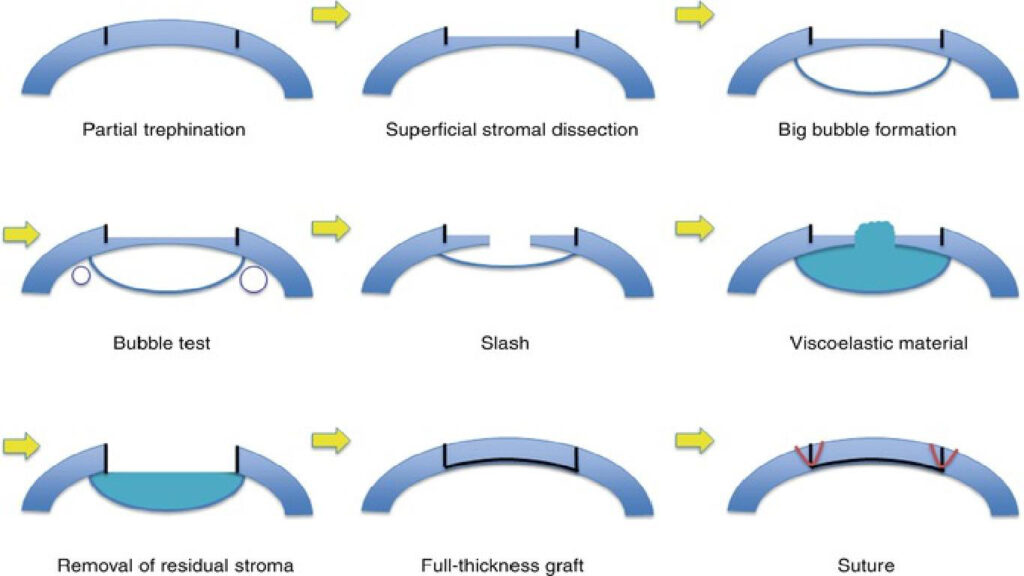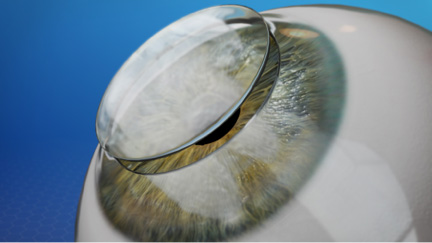Deep Anterior Lamellar Keratoplasty (DALK) is a highly effective surgical treatment for keratoconus, a progressive eye condition that causes the cornea to thin and develop an irregular, cone-like shape. Performed by the expert team at Khanna Vision Institute, DALK is a specialized procedure that addresses the underlying structural issues of keratoconus without the need to replace the entire cornea.
During a DALK procedure, the surgeon carefully removes the diseased anterior layers of the cornea, leaving the healthy posterior layer, or Descemet’s membrane, intact. This targeted approach minimizes the risk of complications and allows for a faster recovery time compared to traditional full-thickness corneal transplants. By preserving the patient’s own corneal tissue, DALK also reduces the likelihood of rejection, a common concern with traditional corneal transplants.

Indications
DALK is particularly beneficial for patients with:
Keratoconus: Especially in advanced cases where the cornea has become significantly distorted and other treatments are ineffective.
Corneal Scarring: From infections or trauma that affect the stromal layers but spare the endothelium.
Corneal Dystrophies: Conditions that primarily affect the corneal stroma.
Procedure
Preoperative Evaluation:
A comprehensive eye examination is conducted to assess the extent of corneal damage and determine the suitability of DALK. Imaging techniques such as corneal topography may be used to map the cornea.
Anesthesia:
This procedure is typically performed under local or general anesthesia.
Corneal Preparation:
The surgeon creates a partial-thickness incision in the cornea to access the diseased stromal layers.
Stromal Layer Removal:
The diseased stromal tissue is carefully removed, leaving the Descemet’s membrane and endothelium intact. This can be done using various techniques, such as manual dissection or air injection (the “big bubble” technique).
Donor Tissue Placement:
A donor corneal button, prepared by removing its endothelium and Descemet’s membrane, is then placed onto the patient’s corneal bed.
Suturing:
The donor tissue is sutured into place, ensuring proper alignment and integration with the patient’s cornea.

Benefits
Reduced Rejection Risk:
Preserving the patient’s endothelium significantly lowers the risk of immune rejection, a common issue in full-thickness transplants.
Improved Visual Outcomes:
DALK can provide excellent visual outcomes, similar to those of penetrating keratoplasty (PK).
Lower Risk of Graft Failure:
The risk of graft failure is reduced due to the preservation of the recipient’s endothelium.
Faster Recovery:
The recovery time can be quicker compared to full-thickness transplants, and there are fewer complications related to endothelial cell loss.
Risks and Considerations
Technical Complexity:
DALK is a technically demanding procedure that requires a skilled and experienced surgeon.
Perforation Risk:
There is a risk of inadvertently perforating the Descemet’s membrane, which may necessitate conversion to a full-thickness transplant.
Visual Rehabilitation:
Full visual rehabilitation may take several months, similar to other corneal transplant procedures.
Intraoperative Challenges:
The “big bubble” technique and other methods to separate the layers can be challenging and may not always result in a perfect dissection.
Postoperative Care
Medication:
Patients are typically prescribed antibiotics and steroid eye drops to prevent infection and control inflammation.
Follow-Up:
Regular follow-up visits are necessary to monitor the healing process, check for signs of rejection, and manage suture-related issues.
Suture Removal:
Sutures may need to be removed or adjusted over time to ensure optimal corneal shape and vision.
Khanna Vision Institute’s skilled ophthalmologists have extensive experience in performing DALK, leveraging advanced surgical techniques and state-of-the-art technology to deliver exceptional outcomes for their patients. With a focus on personalized care and a commitment to staying at the forefront of ophthalmic innovations, the institute has established itself as a leading provider of this transformative keratoconus treatment.
For individuals living with the challenges of keratoconus, the DALK procedure performed at Khanna Vision Institute offers a compelling solution that can significantly improve visual acuity, reduce the need for corrective lenses, and ultimately enhance the overall quality of life. By entrusting their care to the experts at Khanna Vision Institute, patients can feel confident in their path to better vision and a brighter future.